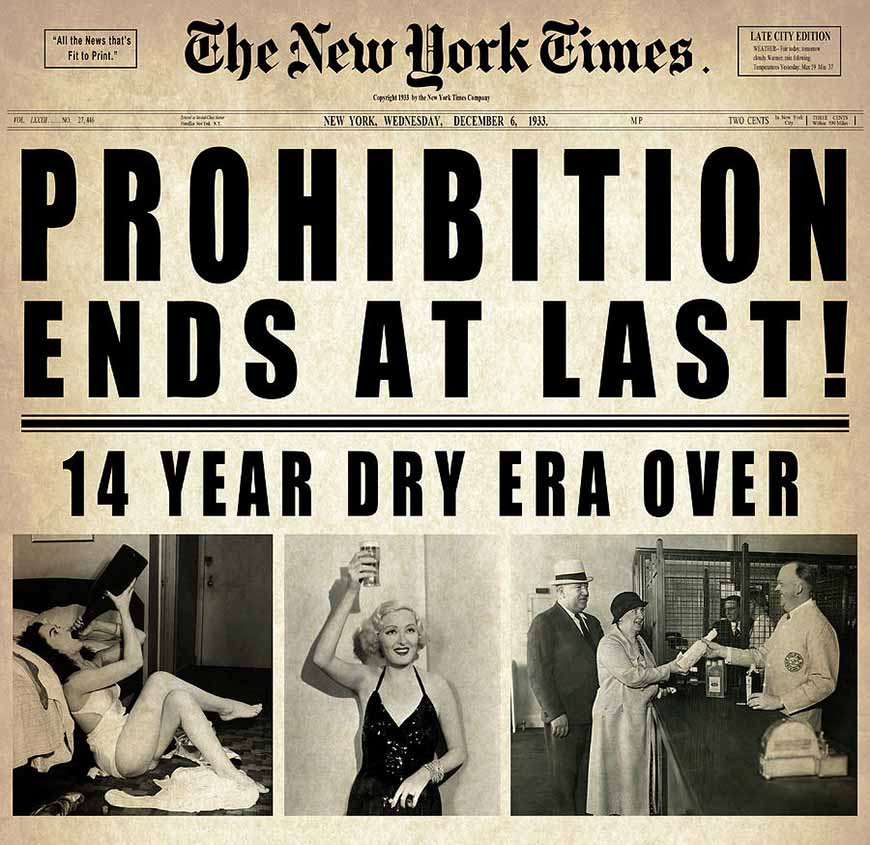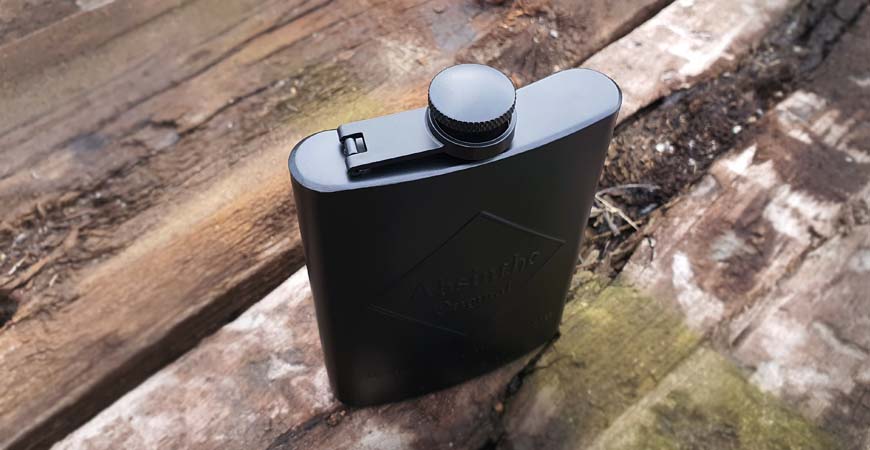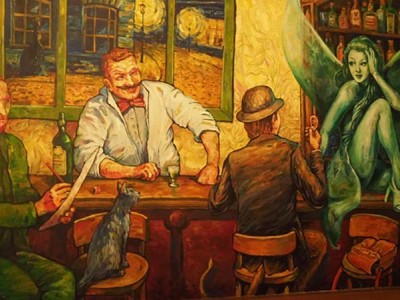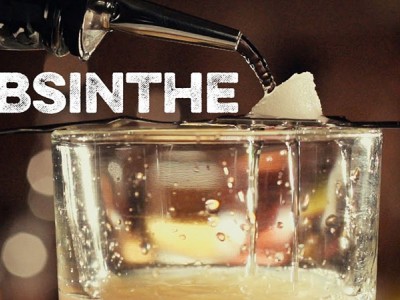The History of The Pocket Flask - Origin, Shape & Prohibition
The History of The Hip Flask
Women and men have been carrying flasks since the 18th Century. They have been discreetly kept in a pocket, purse, or boot leg, so they always had their favorite spirit close by. Although flasks have been around since the Stone Age, the modern flask is a status symbol and a gentleman's or woman's accessory. Before the advent of mini-bars in hotels and 24-hour liquor stores, travelers, soldiers, and rebel rousers could always rely on a flask to keep them company. It's not just for its practicality, but also for the mystery that surrounds a world that was long gone before liquor was readily (or legally) available. Today, we still carry and enjoy our trusted flasks.
Paleolithic humans from the Stone Age may have used animal skin pouches to hold wild grapes and this could be the origin of the flask. Later, in the Middle Ages, flasks were mass-produced from molds so pilgrims could transport oil and water to and from their pilgrimage sites. These flasks were often decorated with elements that represented saints who visited holy places.
The flask we know today was not invented until the 18th century. This is due to improvements in distillation, which allowed for alcohol to be made that can withstand long distances without spoiling. Wine and fermented ales require an airtight seal in order to preserve their freshness. Distilled spirits can be stored in a flask for a while without losing its flavor or alcohol content. This makes it perfect for small amounts that are kept in a glass or metal container.
Although beverage distillation was established in Italy in the 13th century it didn't take long for it to spread across Europe. Boiling wine to high proof was a common and dangerous trick used by alchemists. Hard alcohol was not commercially available until the 17th century, when it was sold as a medical agent.
Slowly, however, some people (including your direct ancestors) realized that this new, booming body tonic was also good at lubricating the mind. The industry boomed like an early still that was always exploding.
Flasks have seen a sharp increase in use and production as liquor became cheaper.
A traveler no longer needed a large canteen of wine, beer or mead to enjoy the fine taste of each destination. You could use a small, concentrated bottle of alcohol that fits in your newfangled pocket.
It's not the easiest thing to grasp: once, we walked around with no pockets. Those who carried small items, such as coins or cash, used to keep them in small pouches that were tied with string to their belts. This made them easy prey for "cut purses", who would rip the string and take the loot. One day, a clever tailor came up with the idea of sewn pouches in the jackets and trousers of the day. This made it harder for people to find and steal your belongings.
The first pocket flasks were invented in the 18th century. They looked like flattened eggs and could easily be slipped into pockets. Though every nobleman who fancied himself as a man-about-town had to have one, an informed guess places the flask's rapid evolution in the knapsacks of professional soldiers rather than the pockets of upper-class scoundrels. The spirits flask was an essential element of a soldier's equipment by this period, especially if the soldier was a professional rather than a conscript.
Soldiers relied on small-quantity vessels for warmth, motivation, courage, and disinfection while on campaign, especially infantry who carried everything on their backs. Furthermore, many of the improvements made to pocket flasks had already been done in a different type of flask that troops carried.
Some flasks were used as holy souvenirs while others were used as weapons of war. Powder flasks were commonplace on battlefields as well as hunting grounds, with the advent of gunpowder & musketry. They were similar to the pocket flask, and the narrow nozzle that allows powder to be injected into barrels was often the only thing that could distinguish them. It was essential to keep your powder dry, so these flasks were watertight. You can simply change the nozzle to make the switch to a spirits flask.
Some flasks were reused for design purposes. Some women's perfume manufacturers began selling their expensive product in plain spirits flasks in the 19th century. This is clever marketing at its best: A husband would be more inclined to buy a costly scent if he received a silver flask at his end of the deal.
A flask revolution was underway on the other side. The United States had a thriving glass industry in the 1800s. They knew exactly what kind of glassware Americans wanted. America in the nineteenth century was a country on the move. They couldn't expect to travel west with full-sized whiskey bottles in their pockets. They flooded the country in what collectors call "historical flasks." These molded, thick-walled, colorful bottles of whiskey were quickly found in pockets of almost every man west and many others on the other side.
These flasks had unique American motifs up until the Civil War. They included the faces of the presidents, flags and log cabins. They were filled with whiskey or spirits and could be purchased at the local pub or liquor store.
Auctions can easily bring high prices for some items. A recent example with the portrait of president Andrew Jackson sold for $151,000. It was a good deal considering that it sold for only a penny in 1820.
Prohibition
In 1919, the United States ratified the 18th Amendment, also known as Prohibition and the hip flask was a key part of America's Prohibition, which prohibited the consumption, production, and distribution of alcohol across the country. The flask was popularized along with the speakeasy as people flouted laws and carried hip flasks filled with whiskey and rum under their clothes to sell, nip at and share.
In the first six months after Prohibition, more hip flasks were sold than in any decade before.

Post-Prohibition
When it was legal again to enter a bar to purchase legal liquor, the popularity of flasks began to decline. It was no longer necessary to carry around a canteen when the drought ended. Many people began to despise the sight of a flask and saw it as a reminder of an evil past. Concurrently, it is believed that American men became less able to drink straight liquor at body temperature in the 1960s.
Some cliques, such as servicemen, bachelors, and traveling salesmen, still loved flasks. Flasks are still popular with adventurers and private eyes, although they were no longer used by those who had access to them. However, by the 1980s, when MADD and recreational drug abuse began to affect flasks, the culture was in decline.
Hip flasks have been gifts for groomsmen from then onwards. They were occasionally seen on the fairways and even in the hands of eccentric artiste. Hollywood occasionally pulls them out as an Instant Character Tell ("Oh, my gosh! He carries alcohol around with him in a handsome, silver container. Thus he is a depraved alcoholic!"). Or a Portable Mood Shifter (and apparently magical as two or three adults getting hammered on the contents a single four-ounce flask).
Flasks have taken on an exotic appearance because they are rarely seen. Produce one, and depending on the nature of the crowd, people may gather around it like a campfire, or they might slink away to safety, because you're clearly trying to cause trouble.
Ernest Hemingway's Silver Flask
It is not known when Ernest Hemingway's long-lasting relationship with the tall, silver pocket flask that he called Jinny began. Hemingway mentions a silver hip flask in several of his stories and books. He first saw it in his possession while he was watching the D-Day attack from the deck of a landing craft.
Jinny was fighting in World War II during the war that "finally opened its seams too many thousand feet". After a charge around France, liberating hotels from the Nazis and engaging in several bloody battles, Hemingway flew long distances home to the USA, where Jinny most likely burst.
Lillian Ross, a writer who wrote Portrait of Hemingway in 1950, described Hemingway drinking from a silver flask. Jinny was retired at the time, so it is most likely that this flask was used by A.E., Hemingway's friend. It was a gift from his fourth and last wife and contained the following inscription: "From Mary With Love." The JFK Presidential Library and Museum is currently hoarding it.
Masonic Flasks
The popularity of the Masonic flask grew between 1810-1830 due to the expansion of Masons. A glass-blown flask, traditionally made in the Northeast by Masons for Lodge meetings. These flasks are identified by the Masonic symbols embossed on the glass during production.
Hip Flask Materials
Without a detailed explanation of the materials used in making flasks, it is impossible to discuss the flasks. Flasks were made mostly of glass, pewter and sterling silver as a result of the advances in the distillation process.
Glass
Blown glass was used for liquid containers since 5000-3500 BCE. It is most commonly used in Masonic flasks. Glass flasks of today are often combined with a base and metal cap to strengthen the fragile glass.
Stainless Steel
Stainless steel is the most widely used material today due to its strength and affordability. Stainless steel is an alloy that resists corrosion and rust. It can also hold liquids well and is easy to clean. The most durable of all the materials, stainless steel is scratch and tarnish-resistant and retains its high polish for many years.
Pewter
Pewter, a malleable metal alloy dating back to the Bronze Age is more expensive than stainless steel, but less than sterling silver. Pewter flasks are known for their distinctive patina, especially in older flasks that have tarnished and turned the metal dark grey. Because of the high lead content in vintage pewter, these flasks shouldn't be stored with liquor but should be kept as heirlooms.
Sterling Silver
Sterling Silver dates back to 12th century England and is the most valuable metal for flask production. Its prices are well over $10k. Sterling silver is made of 92.5% silver and 7.5% other metals, often copper, to make it strong. It's ideal for precious heirloom pieces.
Hip Flask Care And Cleaning
Let's end with a few words about cleaning and care. To remove any residue from manufacturing, rinse your flask several times with water before you use it for the first time. Mix equal amounts of white distilled vinegar with warm water to clean your flask. Then, fill it half-full and shake vigorously. After rinsing, add your preferred distilled spirit. Do not use soap to clean your flask. This will cause a deterioration in the taste of the contents.
Our Own Contribution to The History
How did we get our start? Look at the many hip flasks on Amazon. They are either dull, shiny stainless steel, brushed, or covered in horrible-looking faux leather. We decided to create something better. A hip flask that will be unique, beautiful, and impressive. We then created a flask which not only addressed all the issues mentioned on Amazon but also looked great and came with great gift packaging. This flask is a great addition to our premium absinthe range.
Absinthe Hip Flask, an 8-ounce stainless steel flask, is our contribution to this rich history. To maintain its clean, exclusive appearance, the pocket flask is finished in a matte black finish. It has a subtle refinement that makes it stand out from the other boring flasks. The body has a slight curve that allows you to discreetly keep it in your pocket, true hip flask style. Flask is leakproof and has a cap that is easy to open and close. It also comes with a small funnel to allow for quick refills of your favorite beverage.
This handmade refillable Absinthe hip flask is perfect for sneaking in a quick drink... absinthe or whiskey... this compact device can hold 8oz, which is about 5 shots of your favorite alcohol. These liquor hip flask sets are great gifts for Father's Day, birthdays, retirements, and various other awards. The flasks may be used at the bachelor party if given in time. You can also keep a flask in your tuxedo for a wedding reception.
Hip Flask as a Proven Gift Idea
Over 60% of all flask reviews confirm that hip flasks are successful gifts for Valentine's Day, Father's Day, Congratulations, Promotion, Graduation, and many other occasions. It is without a doubt an unique gift idea for doctors, nurses and military personnel, as well as police officers, brothers, boyfriends, and fathers.






